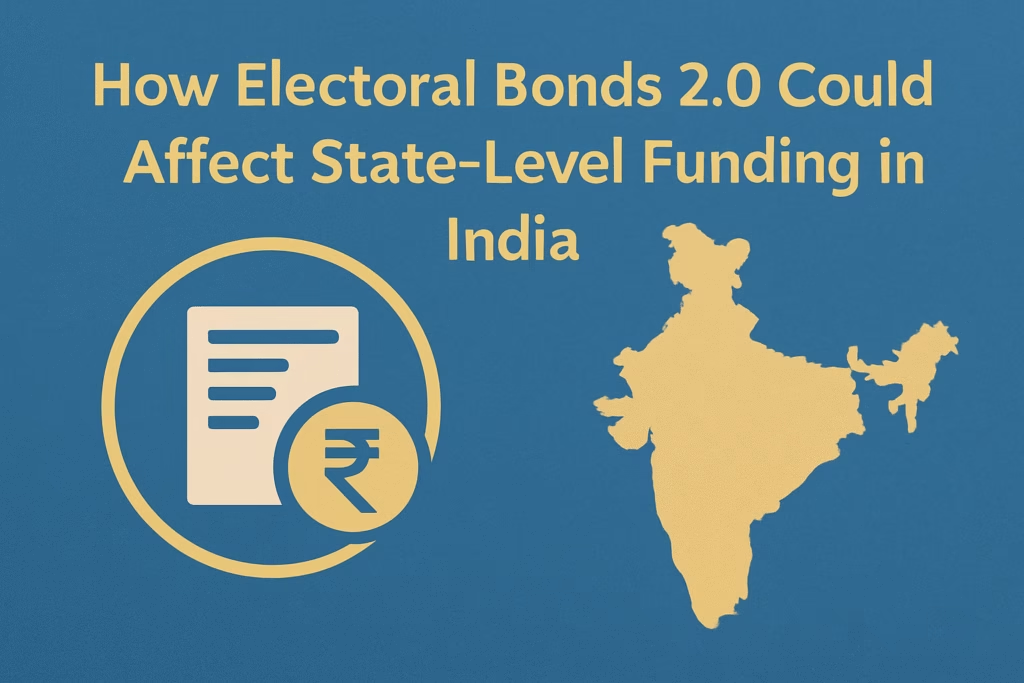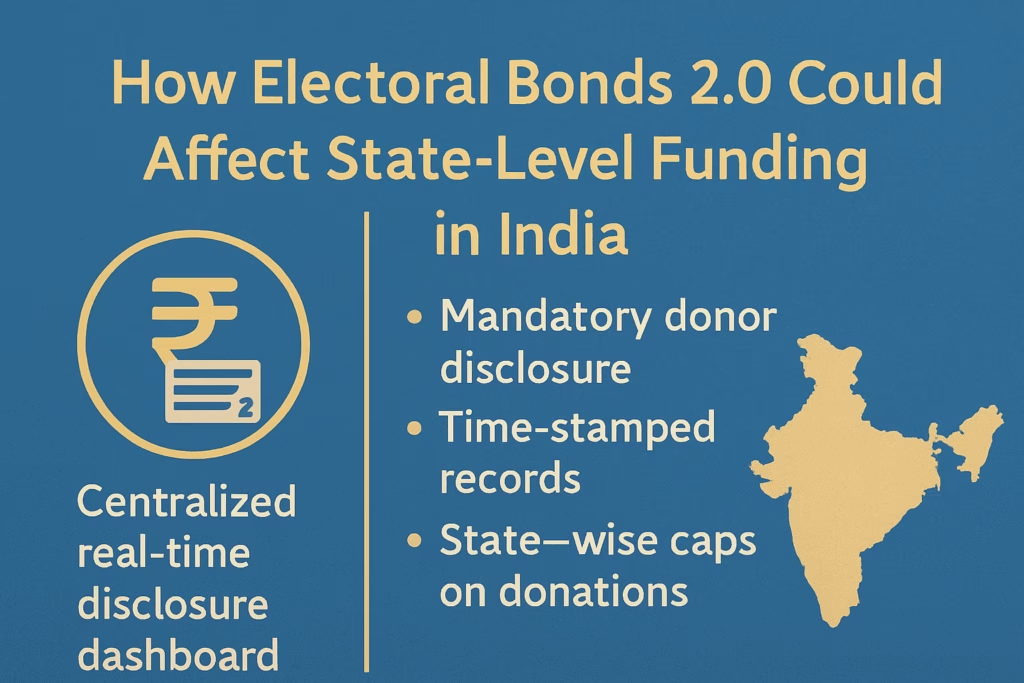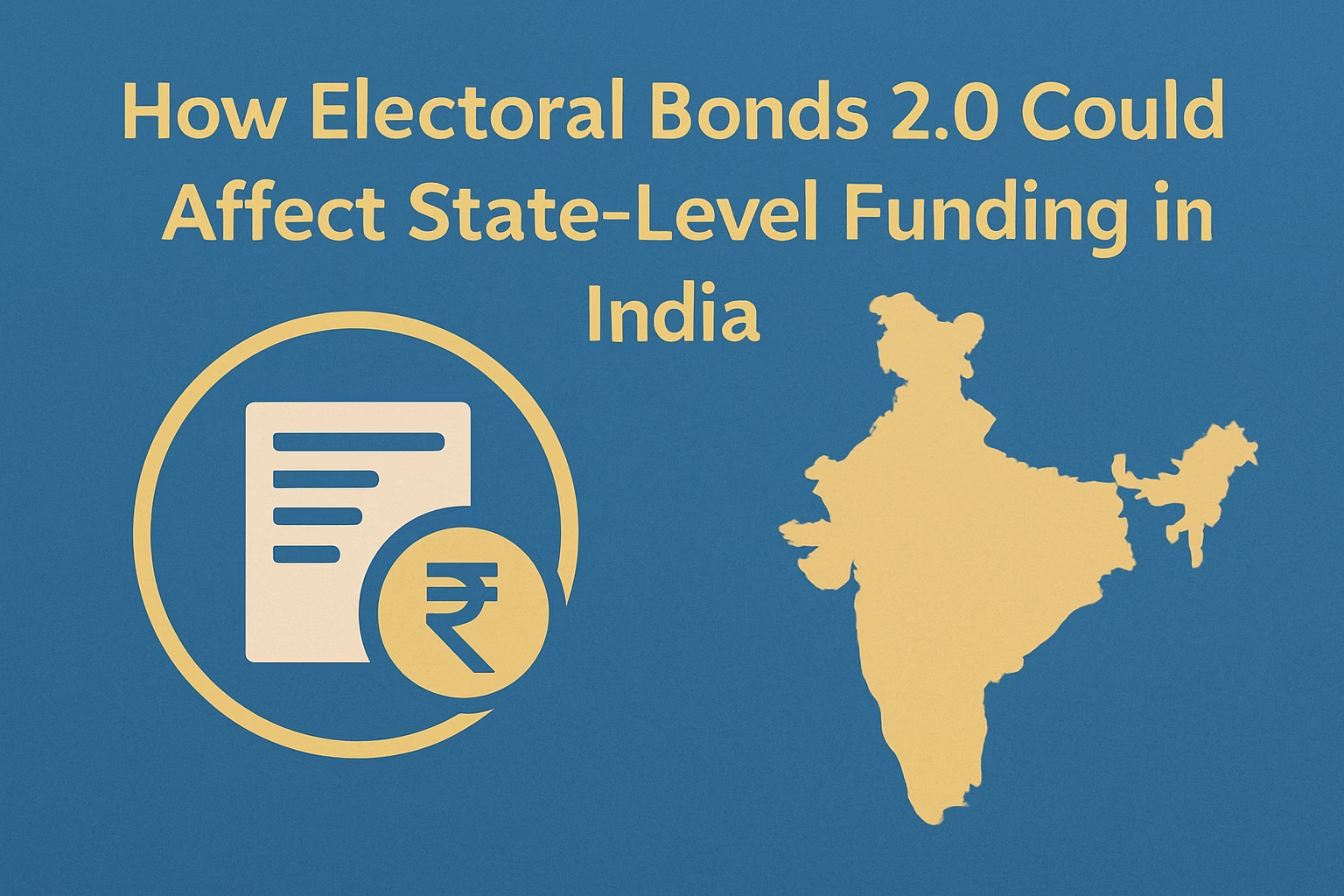In 2025, India’s political funding system stands at a crucial crossroads. After years of criticism, legal challenges, and intense public debate, the government has unveiled Electoral Bonds 2.0—a revised framework that aims to bring more transparency, equity, and accountability into political donations. But while the national headlines focus on broader implications for democracy, there’s a deeper layer that’s being overlooked: how Electoral Bonds 2.0 could affect state-level funding in India.

Political funding in India has long been skewed toward national parties and urban strongholds. With the revised electoral bond system, the playing field could either level out or tilt even further—depending on how implementation plays out. For state parties, especially those outside the media spotlight, the ripple effects of Electoral Bonds 2.0 may define their survival or decline.
This article explores what’s changed in the 2.0 version, how it interacts with regional political ecosystems, and what Indian voters need to watch out for in the run-up to the 2026 elections.
🧾 What Are Electoral Bonds 2.0—And What’s New?
The original electoral bond scheme, introduced in 2018, allowed individuals and companies to donate money to political parties in the form of interest-free bearer bonds issued by the State Bank of India (SBI). While it was framed as a clean, banking-channel-based system to curb black money in politics, critics highlighted its anonymity loopholes, corporate influence, and lack of public transparency.
In 2024, after a landmark Supreme Court verdict and mounting pressure from civil society, the government introduced Electoral Bonds 2.0 with a revamped structure. The key changes include:
- Mandatory donor disclosure for contributions above ₹20 lakh
- Time-stamped records for all bonds purchased and redeemed
- A centralized real-time disclosure dashboard managed by the Election Commission
- Restrictions on shell companies and cross-border donations
- State-wise caps on donations to prevent over-centralization
At first glance, these reforms appear to democratize funding. But the deeper question is: will these rules benefit regional parties or entrench central dominance further?
🗳️ How Electoral Bonds 2.0 Reshapes State-Level Political Funding
One of the most critical shifts under Electoral Bonds 2.0 is the potential rebalancing of financial flows from Delhi-centric parties to regional formations. Earlier, most electoral bond purchases were routed toward national parties like the BJP and Congress, who had access to national corporates and greater media visibility.
However, under the new rules:
- Donor traceability could make corporates more cautious about donating large sums only to ruling national parties, especially if their identity will be made public.
- State-wise caps introduce an upper limit on how much any party can receive via bonds in each state, which could create a more level playing field for parties like DMK in Tamil Nadu, TMC in Bengal, or AAP in Punjab.
- Real-time disclosures could expose lopsided donations and help watchdog groups monitor potential coercion or quid pro quo.
This restructured model means Electoral Bonds 2.0 could affect state-level funding in India by slightly shifting the power dynamic toward local accountability. But it also raises concerns about how these disclosures might deter legitimate donors who fear political retribution from rival state governments.

🏛️ Impact on Regional Parties: Leveler or Limiter?
For regional parties that often run lean campaigns and rely heavily on local donors, Electoral Bonds 2.0 offers both opportunities and risks.
✅ The Positives:
- Greater visibility of who funds whom may force national parties to play cleaner in state elections.
- State parties might now attract more donations from state-specific industries, who previously only backed parties in power at the Centre for “protection.”
- The public nature of data could encourage more civic-minded individuals and businesses to fund smaller parties transparently.
⚠️ The Concerns:
- Regional parties, many of whom operate outside the formal business ecosystem, may still struggle to attract large-ticket donors due to lack of national media access.
- There’s a risk that central investigating agencies could misuse data for selective targeting of donors or parties.
- Some experts argue that the minimum disclosure threshold (₹20 lakh) is still too high and may allow significant opaque funding below that line.
So while Electoral Bonds 2.0 could affect state-level funding in India by increasing visibility, whether it leads to actual equity depends on implementation integrity and institutional fairness.
📈 Corporate Influence: Diversified or Repackaged?
One of the biggest criticisms of the original bond scheme was the unchecked corporate capture of political parties. Companies were allowed to donate unlimited amounts anonymously, and in some cases, shell firms were created solely for the purpose of routing funds.
Electoral Bonds 2.0 tries to tackle this by enforcing:
- Disclosure of corporate donations
- Barring companies less than three years old from participating
- Introducing auditable compliance records
This could help regional parties tap into local business ecosystems—think MSMEs in Gujarat, textile exporters in Tamil Nadu, or agri-cooperatives in Maharashtra—who now feel safer contributing within a regulatory framework.
That said, large conglomerates with national exposure may still prefer to back central parties to hedge political risks, which means regional parties may not yet see the funding volumes necessary to match their national counterparts. In this way, Electoral Bonds 2.0 could affect state-level funding in India by creating an indirect tiered donor economy, where national parties command big donors, and regional parties are left competing over smaller local contributions.
📍 State-by-State Scenarios: Who Gains, Who Loses?
Let’s break down a few specific examples to understand the real-world effects of Electoral Bonds 2.0 on state-level funding:
- West Bengal (TMC): With donor identities public, local industrialists may support TMC openly without fear of ED scrutiny, potentially strengthening its funding.
- Punjab (AAP): Transparency could help AAP secure middle-class urban donors who earlier hesitated to contribute due to fear of exposure.
- Tamil Nadu (DMK vs AIADMK): Both parties may compete more aggressively for clean, large donations, with local IT and manufacturing sectors acting as key funders.
- Northeast regional parties: These parties could struggle more, as donor networks remain weak and most funding still comes from central agencies or discretionary grants.
So while Electoral Bonds 2.0 could affect state-level funding in India, the results will vary dramatically across regions depending on political maturity, business vibrancy, and civic engagement.
READ: How to Check Your Voter ID Rejection and Fix It Online in 2025
🔍 Transparency vs Retaliation: The Fine Line
The most delicate tension created by Electoral Bonds 2.0 is between transparency and fear. While publishing donation data may sound democratic, Indian political culture is still rife with vendetta politics.
For example, if a donor gives ₹50 lakh to a regional opposition party, and that information becomes public, what’s stopping a rival government from using tax raids or regulatory scrutiny as punishment?
This creates a chilling effect, where state-level funding dries up not because of lack of support but because of fear of exposure.
Thus, while Electoral Bonds 2.0 could affect state-level funding in India by allowing cleaner money in, it must be backed by institutional protection for whistleblowers, donors, and regional parties, or else the very purpose of the reform could backfire.
⚖️ Legal Oversight and Federal Concerns
Several constitutional experts have flagged that Electoral Bonds 2.0, despite being an improvement, still leans heavily toward central control. Since SBI remains the sole issuer and data aggregator, and disclosures are funneled through a central platform, state election commissions remain powerless.
This has triggered concerns among federalists who argue that state-level political funding mechanisms must also be decentralized. Some states have begun discussions on setting up parallel donation portals or demanding more granular access to data related to parties operating in their jurisdictions.
So in the long run, Electoral Bonds 2.0 could affect state-level funding in India by creating pressure for decentralization in political finance—a much-needed reform in a country as diverse as India.
🧩 Conclusion: Fixing Funding Without Breaking Federalism
There’s no doubt that Electoral Bonds 2.0 marks progress. It introduces accountability, limits opacity, and attempts to create a fairer political economy. But the real test lies not in its design but in its execution—and nowhere is this test more critical than at the state level.
For India to strengthen its democracy, state parties must not be financially starved. Electoral Bonds 2.0 should be a bridge toward funding equity, not a tool of soft coercion. Regional diversity is the lifeblood of India’s politics, and if Electoral Bonds 2.0 ends up weakening it, the entire nation loses.
As citizens, donors, and observers, we must keep a close eye on how this system evolves and whether it truly empowers the states—or just repackages central dominance under a new name.
FOLLOW TIME OF HINDUSTAN FACEBOOK PAGE

